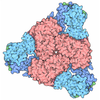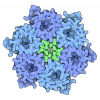[English] 日本語
 Yorodumi
Yorodumi- PDB-3pnu: 2.4 Angstrom Crystal Structure of Dihydroorotase (pyrC) from Camp... -
+ Open data
Open data
- Basic information
Basic information
| Entry | Database: PDB / ID: 3pnu | ||||||
|---|---|---|---|---|---|---|---|
| Title | 2.4 Angstrom Crystal Structure of Dihydroorotase (pyrC) from Campylobacter jejuni. | ||||||
 Components Components | Dihydroorotase | ||||||
 Keywords Keywords | HYDROLASE / TIM barrel / Dihydroorotase / Zinc binding / Structural Genomics / Center for Structural Genomics of Infectious Diseases / CSGID | ||||||
| Function / homology |  Function and homology information Function and homology informationdihydroorotase / dihydroorotase activity / 'de novo' UMP biosynthetic process / 'de novo' pyrimidine nucleobase biosynthetic process / zinc ion binding / cytosol Similarity search - Function | ||||||
| Biological species |  Campylobacter jejuni subsp. jejuni (Campylobacter) Campylobacter jejuni subsp. jejuni (Campylobacter) | ||||||
| Method |  X-RAY DIFFRACTION / X-RAY DIFFRACTION /  SYNCHROTRON / SYNCHROTRON /  MOLECULAR REPLACEMENT / Resolution: 2.4 Å MOLECULAR REPLACEMENT / Resolution: 2.4 Å | ||||||
 Authors Authors | Minasov, G. / Halavaty, A. / Shuvalova, L. / Dubrovska, I. / Winsor, J. / Papazisi, L. / Anderson, W.F. / Center for Structural Genomics of Infectious Diseases (CSGID) | ||||||
 Citation Citation |  Journal: TO BE PUBLISHED Journal: TO BE PUBLISHEDTitle: 2.4 Angstrom Crystal Structure of Dihydroorotase (pyrC) from Campylobacter jejuni. Authors: Minasov, G. / Halavaty, A. / Shuvalova, L. / Dubrovska, I. / Winsor, J. / Papazisi, L. / Anderson, W.F. / Center for Structural Genomics of Infectious Diseases (CSGID) | ||||||
| History |
|
- Structure visualization
Structure visualization
| Structure viewer | Molecule:  Molmil Molmil Jmol/JSmol Jmol/JSmol |
|---|
- Downloads & links
Downloads & links
- Download
Download
| PDBx/mmCIF format |  3pnu.cif.gz 3pnu.cif.gz | 155.8 KB | Display |  PDBx/mmCIF format PDBx/mmCIF format |
|---|---|---|---|---|
| PDB format |  pdb3pnu.ent.gz pdb3pnu.ent.gz | 121.6 KB | Display |  PDB format PDB format |
| PDBx/mmJSON format |  3pnu.json.gz 3pnu.json.gz | Tree view |  PDBx/mmJSON format PDBx/mmJSON format | |
| Others |  Other downloads Other downloads |
-Validation report
| Summary document |  3pnu_validation.pdf.gz 3pnu_validation.pdf.gz | 463.6 KB | Display |  wwPDB validaton report wwPDB validaton report |
|---|---|---|---|---|
| Full document |  3pnu_full_validation.pdf.gz 3pnu_full_validation.pdf.gz | 472.9 KB | Display | |
| Data in XML |  3pnu_validation.xml.gz 3pnu_validation.xml.gz | 28.9 KB | Display | |
| Data in CIF |  3pnu_validation.cif.gz 3pnu_validation.cif.gz | 40.8 KB | Display | |
| Arichive directory |  https://data.pdbj.org/pub/pdb/validation_reports/pn/3pnu https://data.pdbj.org/pub/pdb/validation_reports/pn/3pnu ftp://data.pdbj.org/pub/pdb/validation_reports/pn/3pnu ftp://data.pdbj.org/pub/pdb/validation_reports/pn/3pnu | HTTPS FTP |
-Related structure data
| Related structure data | 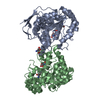 1j79S S: Starting model for refinement |
|---|---|
| Similar structure data | |
| Other databases |
- Links
Links
- Assembly
Assembly
| Deposited unit | 
| ||||||||
|---|---|---|---|---|---|---|---|---|---|
| 1 |
| ||||||||
| Unit cell |
|
- Components
Components
| #1: Protein | Mass: 41263.645 Da / Num. of mol.: 2 Source method: isolated from a genetically manipulated source Source: (gene. exp.)  Campylobacter jejuni subsp. jejuni (Campylobacter) Campylobacter jejuni subsp. jejuni (Campylobacter)Strain: NCTC 11168 / Gene: Cj0259, pyrC / Plasmid: pMCSG7 / Production host:  #2: Chemical | ChemComp-ZN / #3: Chemical | #4: Water | ChemComp-HOH / | |
|---|
-Experimental details
-Experiment
| Experiment | Method:  X-RAY DIFFRACTION X-RAY DIFFRACTION |
|---|
- Sample preparation
Sample preparation
| Crystal | Density Matthews: 2.64 Å3/Da / Density % sol: 53.33 % |
|---|---|
| Crystal grow | Temperature: 295 K / Method: vapor diffusion, sitting drop / pH: 6.5 Details: Protein: 7.7 mg/mL, 0.25M Sodium cloride, Tris-HCl (pH 8.3); Screen: PACT (F9), 0.2M Potassium/Sodium tartrate, 0.1M Bis TRIS propane (pH 6.5), 20% w/v PEG 3350., VAPOR DIFFUSION, SITTING DROP, temperature 295K |
-Data collection
| Diffraction | Mean temperature: 100 K |
|---|---|
| Diffraction source | Source:  SYNCHROTRON / Site: SYNCHROTRON / Site:  APS APS  / Beamline: 21-ID-G / Wavelength: 0.97856 Å / Beamline: 21-ID-G / Wavelength: 0.97856 Å |
| Detector | Type: MARMOSAIC 300 mm CCD / Detector: CCD / Date: Nov 12, 2010 / Details: Beryllium lenses |
| Radiation | Monochromator: Diamond / Protocol: SINGLE WAVELENGTH / Monochromatic (M) / Laue (L): M / Scattering type: x-ray |
| Radiation wavelength | Wavelength: 0.97856 Å / Relative weight: 1 |
| Reflection | Resolution: 2.4→30 Å / Num. all: 35063 / Num. obs: 35063 / % possible obs: 100 % / Observed criterion σ(I): -3 / Redundancy: 7.4 % / Biso Wilson estimate: 51.2 Å2 / Rmerge(I) obs: 0.079 / Net I/σ(I): 25 |
| Reflection shell | Resolution: 2.4→2.44 Å / Redundancy: 7.5 % / Rmerge(I) obs: 0.559 / Mean I/σ(I) obs: 3.8 / Num. unique all: 1709 / % possible all: 100 |
- Processing
Processing
| Software |
| |||||||||||||||||||||||||||||||||||||||||||||||||||||||||||||||||||||||||||||||||||||
|---|---|---|---|---|---|---|---|---|---|---|---|---|---|---|---|---|---|---|---|---|---|---|---|---|---|---|---|---|---|---|---|---|---|---|---|---|---|---|---|---|---|---|---|---|---|---|---|---|---|---|---|---|---|---|---|---|---|---|---|---|---|---|---|---|---|---|---|---|---|---|---|---|---|---|---|---|---|---|---|---|---|---|---|---|---|---|
| Refinement | Method to determine structure:  MOLECULAR REPLACEMENT MOLECULAR REPLACEMENTStarting model: 1J79 Resolution: 2.4→29.52 Å / Cor.coef. Fo:Fc: 0.961 / Cor.coef. Fo:Fc free: 0.934 / SU B: 7.429 / SU ML: 0.174 Isotropic thermal model: Thermal factors individually refined Cross valid method: THROUGHOUT / ESU R Free: 0.255 / Stereochemistry target values: MAXIMUM LIKELIHOOD / Details: HYDROGENS HAVE BEEN ADDED IN THE RIDING POSITIONS
| |||||||||||||||||||||||||||||||||||||||||||||||||||||||||||||||||||||||||||||||||||||
| Solvent computation | Ion probe radii: 0.8 Å / Shrinkage radii: 0.8 Å / VDW probe radii: 1.2 Å / Solvent model: MASK | |||||||||||||||||||||||||||||||||||||||||||||||||||||||||||||||||||||||||||||||||||||
| Displacement parameters | Biso mean: 42.677 Å2
| |||||||||||||||||||||||||||||||||||||||||||||||||||||||||||||||||||||||||||||||||||||
| Refinement step | Cycle: LAST / Resolution: 2.4→29.52 Å
| |||||||||||||||||||||||||||||||||||||||||||||||||||||||||||||||||||||||||||||||||||||
| Refine LS restraints |
| |||||||||||||||||||||||||||||||||||||||||||||||||||||||||||||||||||||||||||||||||||||
| LS refinement shell | Resolution: 2.4→2.462 Å / Total num. of bins used: 20
|
 Movie
Movie Controller
Controller





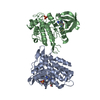
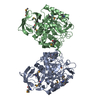
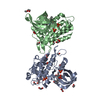
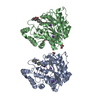


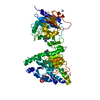
 PDBj
PDBj